Toyota Corolla (E120) 2002–2008 Repair Manual / Theft deterrent & door lock / Toyota vehicle intrusion protection system
Toyota Corolla (E120): Toyota vehicle intrusion protection system
On–vehicle inspection
1. Outline of toyota vehicle intrusion protection (tvip) system
Hint
: the theft deterrent system has 2 modes; one is the active mode that is an initially set mode and another is the passive mode that can be switched on/off by the specified method (see step 4).
- when the theft deterrent system detects any theft, the system will sound the horns and flash the lights to alert the people around the vehicle to the theft.
Hint
: each mode (active and passive) has 4 states; disarmed state, arming preparation state, armed state, alarm sounding state.
- Disarmed state:
- the user is near the vehicle.
- The alarming function does not operate.
- The theft deterrent function does not operate.
- Arming preparation state:
- time from the user locks a door to leave the vehicle.
- Time for transferring to the armed state.
- The theft deterrent function does not operate.
- Armed state:
- the user leaves the vehicle completely.
- The theft deterrent function operates.
- Alarm sounding state:
once a theft is detected in the armed state, the system will sound the horns
and flash the lights
to alert the people around the vehicle to the theft.
Refer to the table for the alarming method and time.

Hint
: in the alarm sounding state, when either of the front doors is unlocked and no key is inserted in the ignition key cylinder, forced door lock signal is output.
2. Active arming mode
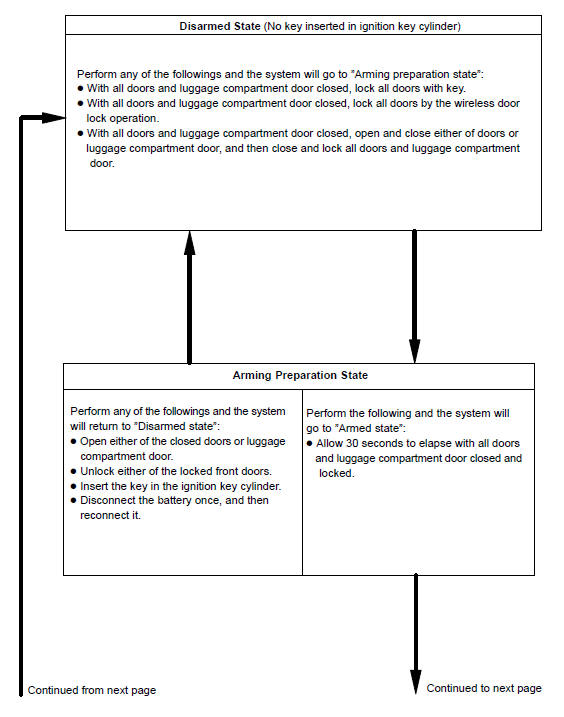
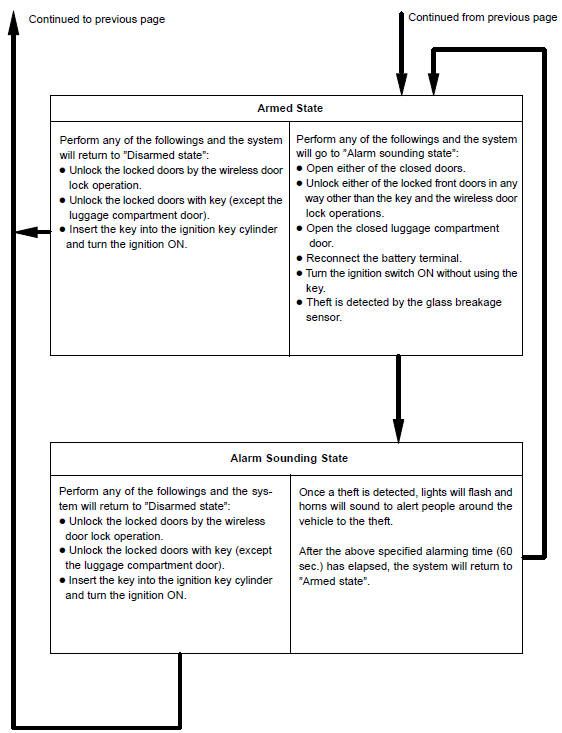
Indicator light output:

Hint:
blinking frequency:
0.2 Seconds (on)
1.8 Seconds (off)
3. Passive arming mode
- this mode can be switched according to the specified method (see step 4).
- Initially set mode (when shipped from factory) is the active mode (no passive mode).
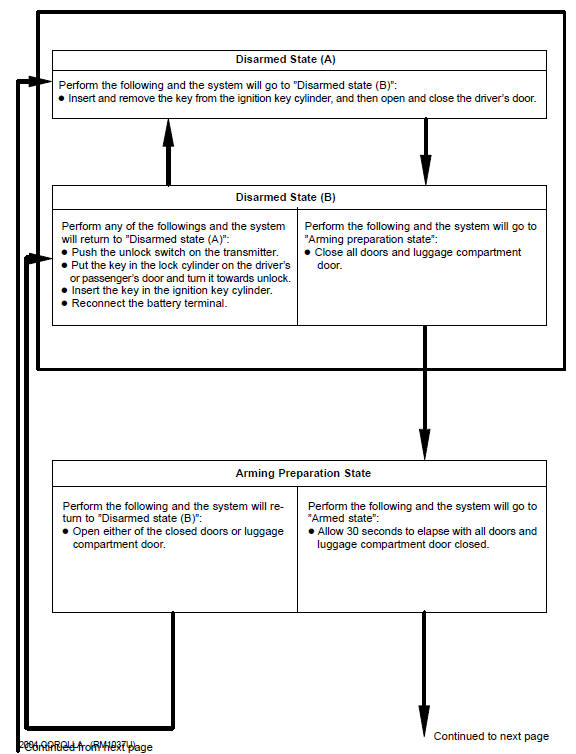
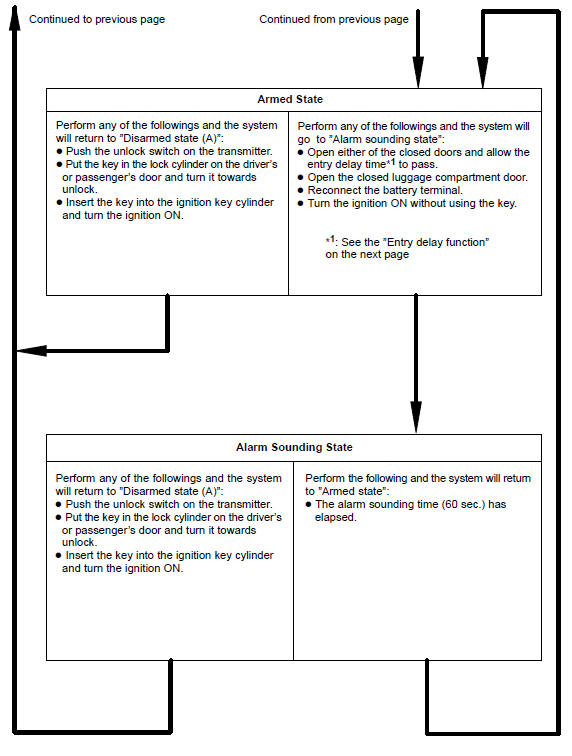
Entry delay function:
Hint
: in the armed state, if either closed door is opened, entry delay time will start.
If the transferring condition (armed state " disarmed state) is satisfied during this entry delay time, the system will transfer to the disarmed state. However if the condition is not satisfied, the system will judge it to be a theft, and then the system will transfer to the alarm sounding state.
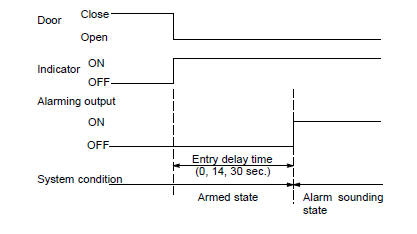
Hint
: the entry delay time can be selected among 0, 14, 30 seconds by the customizing function.
Indicator light output:

Hint
:
blinking frequency:
0.2 Seconds (on)
1.8 Seconds (off)
Transfer to the active mode:
Hint
: in each state of the passive mode, when the transferring condition to the active mode (disarmed state of active mode " arming preparation state of active mode) is satisfied, the system will transfer to each state of the active mode. In this case, the active mode will continue until the system transfers to the disarmed state.

4. Changing method of passive mode (on or off)
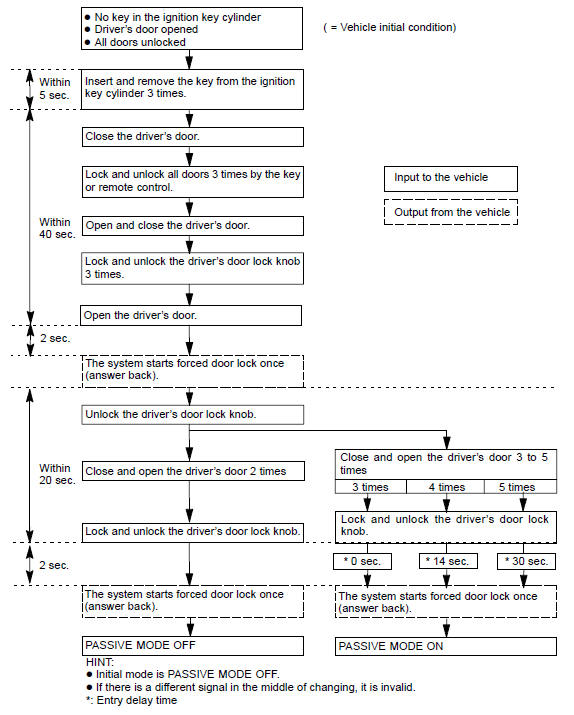
5. Forced door lock control
- Forced door lock is a control that prevents intrusion into vehicles. When a door is unlocked (when an alarm starts), instantaneously forced door lock will be executed.
- Condition to execute forced door lock:
detecting any or all of the following conditions activates forced door lock.
- Theft deterrent system is in the alarm sounding state of the active mode.
- No key is in the ignition key cylinder.
- Any of the front doors is unlocked.
- Since the previous forced door lock, 0.38 Seconds or more have elapsed.
- Conditions to stop forced door lock: detecting any of the following conditions stops forced door lock.
- All doors are locked.
- The alarm has finished.
- The key is inserted into the key cylinder.
6. Operate glass breakage sensor
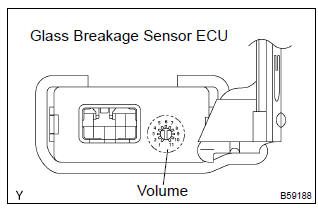
- If the glass breakage sensor detects the glass is broken (at 1st time), the sensor will issue an alarm for 20 seconds (pre–alarming). If the glass breakage sensor detects the glass is broken further more (at 2nd time), the sensor will issue an alarm for 60 seconds.
- the sensitivity of the glass breakage sensor can be adjusted by the volume switch in the glass breakage sensor ecu.
Hint
: because the glass breakage sensor has a high sensitivity, it might issue a wrong alarm if it is adjusted in the volume of high sensitive.
Other materials:
USB Port/AUX Port
Connect an iPod, USB memory device or portable audio player to the USB/AUX
port as indicated below. Select “iPod”, “USB” or “AUX” on the audio source selection
screen and the device can be operated via multimedia system.
Connecting using the USB/AUX port
■ iPod
Open the cove ...
Inspection procedure
Hint:
if dtcs p0115, p0116, p0117, p0118 and p0125 are output
simultaneously, the engine coolant temperature
sensor circuit may be open or short. Perform the troubleshooting of dtc
p0115, p0117 or
p0118 first.
Read freeze frame data using the hand-held tester or the obd ii scan
to ...
Inspection procedure
1 Inspect terminal voltage(idl)
Remove the cruise control ecu assy with connector still
connected.
disconnect the ecm connector.
turn the ignition switch to on.
measure voltage between terminal 13 (idl) of cruise control
ecu assy connector and body ground when the ...


